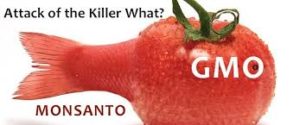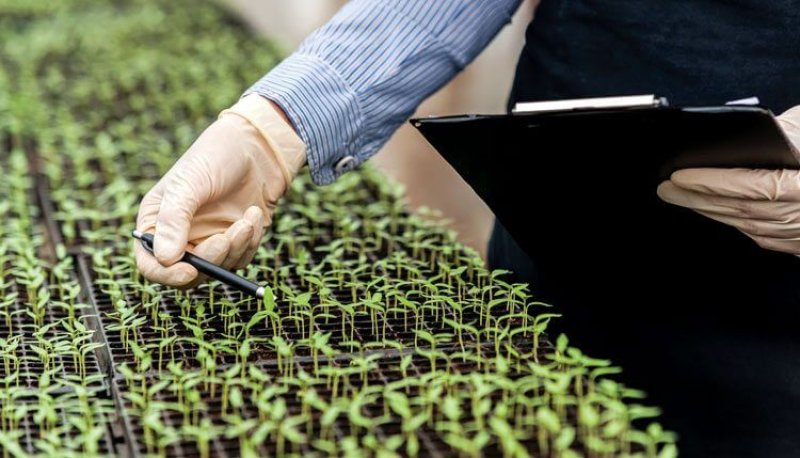If you put a fish gene into a tomato, is it sill a tomato? Or might it morph into something new and unexpected – a fish-mato, perhaps?
A common objection voiced by activists opposed to genetic modification is that the crop will go through some sort of fundamental change. That’s where they came up with the term “Frankenfood.” The fear is that breeders will mess around and create some novel trait or characteristic – a surprise, if you will. It’s an argument leveled, in particular, at transgenic breeding practices, where genetic material from unrelated species is combined. The fast-growing AquaBounty salmon, for example, includes material from the eel-like ocean pout. It should be noted, however, that breeding increasingly is shifting to cisgenic techniques, where no foreign DNA is involved.
Critics argue that these unexpected results will compromise the integrity of the food and possibly create unexpected and hazardous situations, as described by the anti-GMO Earth Open Source, in its list of “GMO myths”:
The GM transformation process may produce mutagenic effects that can disrupt or alter gene structure, disturb normal gene regulatory processes, or cause effects at other levels of biological structure and function. These effects can result in unintended changes in composition, including new toxins or allergens and/or disturbed nutritional value.
The problem with this line of thought is that “unintended” and “unexpected” are not the same thing, though critics — and regulators — generally use the terms interchangeably, says Wayne Parrott, a professor of plant breeding and genomics at the University of Georgia. As a result, he says GM plant breeding has been subjected to a great deal of unnecessary testing.
Parrott maintains that unexpected or surprise effects have never happened in either GMO or traditional breeding. What has happened are “unintended” effects that were actually quite predictable. Traditional breeders have always been watchful for these “unintended” effects and avoid used strains that might cause them. And since breeders are well aware of the properties of the strains they are attempting to cross, he said there’s no need to regulate GMOs based on the potential for “unintended effects.”
 That’s not to say that new traits aren’t created. According to a 2012 paper by a consortium of scientists, conventional breeding in 19 crops took 111 genes from wild relatives and integrated them — without using transgenic techniques — into new varieties. These traits resulted in disease resistance, as well as resistance to abiotic stresses — things such as drought or excessive water — and enhanced plant quality. The paper also points out a regulatory gap between conventional and GM food:
That’s not to say that new traits aren’t created. According to a 2012 paper by a consortium of scientists, conventional breeding in 19 crops took 111 genes from wild relatives and integrated them — without using transgenic techniques — into new varieties. These traits resulted in disease resistance, as well as resistance to abiotic stresses — things such as drought or excessive water — and enhanced plant quality. The paper also points out a regulatory gap between conventional and GM food:
Although the genetic and biochemical bases for these traits are usually not well understood, conventional breeding has successfully stacked traits to create stable crop varieties that are considered safe and that, in most cases, were not subjected to safety assessments prior to commercialization.
Same monitoring, but more for GMOs
Genetically modified plants, are required to undergo testing for changes in phenotype that might result in allergenicity or other harmful effects. Traditional breeders, on the other hand, are free to go about their business of making new strains without having to report their crops to the government.
The reality is that the traits appearing in these traditional plants can vary a great deal — possibly more than the variation seen in GMO plants. According to a 2014 paper by Monsanto regulatory affairs manager Daniel Goldstein, and a National Research Council report in 2004:
It has long been recognized that conventional technologies (which include wide or forced crosses, plant embryo rescue, and chemical or radiation induced mutagenesis) can also result in unanticipated phenomenon and that the risk of GM technologies falls within the range of risks entailed with conventional methods.
A review paper published in 2013 by Dow AgroSciences scientist Rod Herman and retired US Food and Drug Administration official William Price observed that FDA evaluations of 148 transgenic products were substantially equivalent to conventional varieties.
Variation resulting from traditional breeding and environmental factors dwarf any changes observed in the composition due to introducing a trait through transgenesis. For example, white potatoes contain high levels of toxic glycoalkaloids, and up-regulation of these compounds due to traditional breeding can cause sickness. In the aforementioned case of up-regulation of glycoalkaloids, this actually occurred when endogenous insect resistance was selected for by breeders without knowledge of the mechanism for this resistance.
Still, there have been reports, including this one by National Academy of Sciences in 2005, urging scrutiny of all plant breeding. Among its findings:
All foods, whether or not they are genetically engineered, carry potentially hazardous substances or pathogenic microbes and must be properly and prudently assessed to ensure a reasonable degree of safety.
History provides examples of traditional breeding that resulted in potentially hazardous foods. Solanaceous (tobacco family) crops, such as potato and tomato, naturally produce various steroidal glycoalkaloids. These substances are toxic not only to humans, but also to insects and pathogenic fungi. During the course of ordinary plant breeding assessments, breeding lines with increased levels of glycoalkaloids may be identified by the breeder as showing superior insect or disease resistance and retained for possible commercial release.

Still waiting for surprises from modified genetics
Critics looking for evidence of a “surprise” event might be tempted to point out the troubles that surrounded the development of kiwifruit, as detailed in the NAS report:
Originally it was an edible but unpalatable plant producing small, hard berries in China. Breeders in New Zealand developed what we know now as kiwi fruit (Actinidia deliciosa) into a food during the twentieth century, and commercialized in the United States during the 1960s. There does not, however, appear to be any official record of a premarket safety analysis of the fruit. As a consequence, some humans who were not previously exposed to kiwi fruit developed allergic reactions.
Still, Parrott argues that there was no surprise, but rather a lack of expertise that would have identified the potential for problems. The effects cited by the NAS as “surprise” effects of genetic engineering were in fact, not surprises but effects that could be predicted, and in traditional breeding, often are. “They could have used some plant breeders on that study,” he said. “Nobody has had a true surprise effect.”
A version of this article originally ran on the GLP on Jan 25, 2017.
Andrew Porterfield is a writer, editor and communications consultant for academic institutions, companies and non-profits in the life sciences. He is based in Camarillo, California. Follow @AMPorterfield on Twitter.































